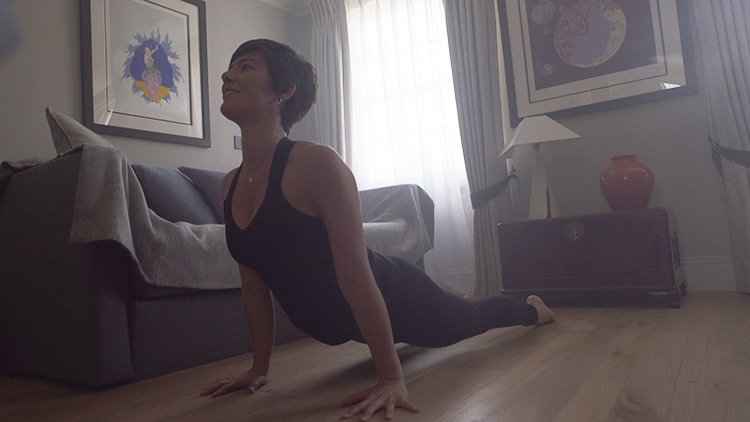Curious about deepening your yoga journey? Yoga teacher and life coach Tracy Johnson outlines how to move your practice to the next level!
When we have been practising yoga regularly over time, attending classes or rolling out the mat at home, we can reach a point where it is a non-negotiable part of our week. Without that mat time we become grumpy and our bodies tighten, and we may start to see the world through less forgiving eyes. Yoga has the power to make us feel like better people when we practise with consistency, behaving towards others with greater kindness and compassion, as well as becoming more sensitive to our own needs and motivations.
When we feel ready to start living a more yogic lifestyle and embody the yoga values, this is usually a sign of a deepening practice that can lead to a great deal of personal peace and satisfaction – a yoga upgrade, in fact! Here are some ways in which you can start to enrich your yoga life.
1. Consider what yoga is really meant to be
Possibly the most well-known of the yoga texts is Patanjali’s Yoga Sutras, where the concept of the Eight Limbs was laid out for the first time, offering a guide for living a meaningful life. Produced roughly around the second or third century CE, they are notable for not referring to the physical practice of yoga, or asana, at all.
The most famous of the Sutras (short verses containing spiritual advice) is the second, and is one all yogis should know: ‘Yogah citta vritti nirodhah’, or, ‘The restraint of the modification of the mind-stuff is Yoga.’ The practice of yoga is to still the mind and that is ultimately our aim on the mat: not to pull off advanced poses or find our head on our knee in a forward bend, but to bring awareness to each movement and each moment, drawing our focus further inward and letting our thoughts flow past and drift away. Remember this when you feel that you ‘need’ your physical practice to be yogic; taking a breath, focusing on those inhalations and exhalations and letting angry thoughts pass is also practising yoga.
2. Observe the Yamas and Niyamas
Another way to bring yoga into your life beyond asana is to start living according to the values of the Yamas and Niyamas, the controls and restraints that make up the first two of the Eight Limbs (asana is the third). You can find full descriptions of each of these values online, and while the concepts of imposing controls and restraints on ourselves sounds harsh, it is important to remember that we do this willingly in order to strive for a better life.
For example, one of the Yamas, ahimsa, means not harming yourself or others. This can mean harm in a literal, physical sense, but also not thinking unpleasant thoughts or spreading malicious gossip about others, or even thinking negatively about yourself. This is something most of us would wish to avoid anyway, but it’s a useful corrective when we want to say something about someone that sounds witty and raises a laugh when, if repeated directly to the person you are thinking of, would be upsetting and hurtful.
Tapas, a Niyama, is all about self-discipline. This doesn’t mean living the life of a spiritual recluse but refers more in our modern age to looking after our body by eating healthy food, for example, and not indulging in behaviours to excess, such as drinking alcohol or attaching in an unhealthy way to relationships. Looking after our own body and mind is a very yogic thing to do and actually paves the way for us to be able to take care of others more effectively, without neglecting our own wellbeing.
3. Ground yourself through meditation
Dhyana is the seventh of the Eight Limbs and is all about meditation. Our teachers may have introduced us to yoga with short periods of meditation in class but, in my experience as a yoga instructor, I often find those who come for a vigorous vinyasa practice become impatient with sitting and focusing on the breath and just want get moving in the ‘real’ yoga practice. Bear in mind that meditation is an intrinsic aspect of yoga and it’s also a discipline that science is starting to recognise as beneficial for our brain chemistry, making us less aggressive as well as more able to step back from stress and think more calmly about how to deal with a problem.
Start your meditation practice with as little as five to 10 minutes a day; this is enough to start feeling the benefits. It can be helpful to use a guided practice from a source such as Movement for Modern Life to give you a framework. Otherwise, just focus on the breath. The objective of meditation is not to empty the mind; this is an impossible task. If we keep bringing our focus back to the breath, then we are meditating. Performed daily over time, this will feel as essential as the physical practice of yoga, offering a mental tune up and a way to step away from the stresses of daily life.
Those are just three ways in which you can upgrade your yoga practice and start to live the yoga values away from the mat, so why not give them a try and work further towards a happy and peaceful life?
>> CHECK OUT OUR GUIDED MEDITATION VIDEOS >>
This post was written by Tracy Johnson, the founder of Brainbox Coaching and Empower Yoga Bristol. She trained under Sally Parkes and is a 200 hour RYT with Yoga Alliance. Tracy blends her yoga teaching with confidence coaching and stress management to create a holistic practice, and runs her classes with warmth and humour. She is the author of a careers guide, Working in Science, co-author of The Coaching Gurus, and writes for publications such as OM Yoga Magazine, Globe of Love, Happiness+Wellbeing, MindBodyGreen and has been featured in the Guardian, Body Fit magazine, the Bristol Post and Cardiff Life. She is also a career and confidence coach, self-defence instructor and an Integrative Nutrition Health Coach, and is currently writing a book combining yoga with her coaching techniques for stress management. Follow Tracy on Twitter.







Leave a Reply